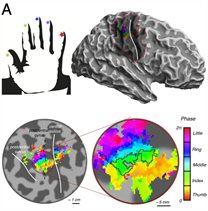Can we see where and when these fireworks end up/start and finish? Turns out, with advanced imaging techniques such as fMRI and MEG, we can.
Next time you try shuffling a pack of cards, think about those receptors in your fingers, feeling, reacting, judging; yes, your hands are magical, and novel research performed here at the SPMIC allows us to unmask those invisible firework displays.
Summary
- The somatosensory cortex is the functional area in the brain representing touch.
- Previous studies of digit somatotopy (mapping the region of sensory space on your skin to the activated area in your brain) have used UHF-fMRI at 7T, and a 'travelling wave' paradigm to identify individual digits and phalanges.
- The aim of this project is to characterise the human tactile somatosensory system in healthy subjects and investigate how it is altered in clinical conditions.
- This is multidisciplinary project including experts in MR physics, advanced neuroimaging and signal processing, affective neuroscience and clinical neurophysiology; who will be exploiting mulitiple image modalities such as MEG (magnetoencephalography), and INMS (intraneural microstimulation).

Somatotopic mapping of the digits at 7 T (Sanchez-Panchuelo et al. 2012)